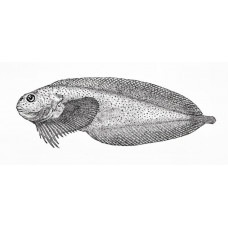Latin name
Liparis fabricii
Other name
Gelatinous snailfish
Identification
The body shape of the Gelatinous seasnail resembles a tadpole with a large rounded head and abdomen tapering to a narrow tail. There are two nasal pores on each side of the head. The eyes are relatively large, with orbital diameters ranging from 5.3 to 10.3% of total body length. The mouth is shaped like a suction disk and has simple teeth without lobes. The body is smooth and completely without scales. The skin has a somewhat gelatinous texture and is easily torn.
Features of fish fins
The pectoral fins of these fish are large, with the tip reaching the anal fin. The pelvic fins, located just below the pectoral fins, are modified in the form of a suction disk. Both the anal fin and the single dorsal fin are very large, beginning about halfway down the body where they overlap the small rounded caudal fin. The number of soft rays on the anal fin ranges from 37 to 42, which distinguishes them from other seasnails species that usually have only 36. The dorsal fin has 45 to 50 rays. The tail fin is rounded and small.
Fish colouring
The coloration of the Gelatinous seasnail is brown to black, with a characteristic dark peritoneum. As juveniles, these fish are lighter in color, with pigment cells (melanophores) visible as brownish spots just under the skin. As they mature, the number of pigment cells increases until the adult fish is almost completely black. Males also develop small tubercles when they reach sexual maturity.
Distribution
This species has the northernmost distribution among seasnails. It has been found in the Barents Sea, Beaufort Sea, Kara Sea, East Siberian Sea, Chukchi Sea, White Sea, Bering Sea, Hudson Bay, Baffin Bay, and the northernmost region of the North Atlantic. The species is also common near Greenland and Franz Josef Land. They inhabit the circumpolar Arctic in waters with temperatures below 0°C (32°F).
Habitat
It is a deep-sea benthopelagic species and inhabits depths from 5 to 1,800 m (16 to 5,906 ft), from the surface of pack ice in open water to the deep seafloor. It usually prefers muddy substrates at depths of 50 to 100 m (160 to 330 ft), although adults are often seen on muddy sandy bottoms with rocks, usually near algae, at depths of 10 to 25 m (33 to 82 ft) on Franz Josef Land.
Size
Males of this species reach a maximum length of 21.0 cm and females 12.7 cm.
Behavior
They occur in schools, as evidenced by trawl surveys that have captured many hundreds of individuals in a relatively short period of time.
Food and feeding habits
Gelatinous seasnails prey on small crustaceans and marine worms. In addition to polychaetes and small bottom crustaceans, pelagic crustaceans, especially Hyperiidae (Themisto libelula, Themisto abyssorum), play a very important role.
Reproduction
Gelatinous seasnail eggs are larger than those of Liparis liparis, the diameter of the eggs being 2.1-2.7 mm (Liparis liparis 1.4-1.7 mm). Eggs of three sizes are observed in the ovaries; during fall spawning (September-October), only large eggs are likely to be deposited. The number of large and medium-sized eggs in Kara specimens ranges from 485 to 735. The larvae are pelagic.
Fishing
This species is not commercially targeted, but is a common bycatch in Arctic fisheries.
Relationship with a person
Harmless to humans is a species of fish.
| Classification | |
| Phylum | Chordata |
| Class | Actinopterygii |
| Squad | Perciformes |
| Family | Liparidae |
| Genus | Liparis |
| Species | L. fabricii |
| Features | |
| Conservation status | Not Evaluated |
| Habitat | Pelagic |
| Life span, years | No information |
| Maximum body weight, kg | No information |
| Maximum length, cm | 21 |
| Sailing speed, m/s | No information |
| Threat to people | Not edible |
| Way of eating | Predator |
Gelatinous seasnail
Tags: gelatinous seasnail

